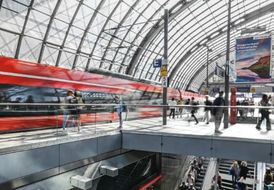Passenger transport
Anticipated market development / % | 2022 | 2023 |
German passenger transport (based on pkm) | +8.4 | +4.5 |
As of February 2023.
Forecast for 2023 rounded to half percentage points.
In 2022, the German passenger transport market recovered noticeably, but remained well below the pre-Covid-19 level. The recovery effects are expected to continue in 2023, but to a lesser extent. The development of demand for transport strongly depends on the infection situation, regulatory measures, economic developments and the associated mobility behavior of the population. Over the long term, commuter transport and business travel will be replaced noticeably by mobile work and digital communication.
- Motorized individual transport is expected to be close to pre-Covid-19 performance levels in 2023. However, rising and persistently high fuel prices as a result of the war in Ukraine and the increase in CO₂ tax dampen growth in volume sold.
- Domestic air transport is expected to claw back further Covid-19-related losses in 2023. However, the market share is likely to remain at a low level.
- Public road passenger transport is expected to increase noticeably again. The introduction of the Germany-Ticket on May 1, 2023, should have a positive effect on local transport. Long-distance bus services are expected to grow more slowly in comparison due to strong competition from rail passenger transport.
- Continued growth in local and long-distance transport is expected for rail passenger transport. Long-distance transport should also win passengers from the air and bus long-distance transport sector and from the motorized individual transport sector if fuel prices continue to be high. Local transport will benefit greatly from the Germany-Ticket. The main premises for this development are consistently low levels of Covid-19 infections and an again increasing confidence in public transport, as well as the desire for a shift in the mode of transport.
In European passenger transport, too, development will be specific to the mode of transport and will vary from region to region. Strategic realignment of providers makes a consolidation of the mobility market probable. However, the progressive climate policy of the EU and its member states remains the long-term engine powering the development of environmentally friendly public mobility – and therefore rail passenger transport in particular.


